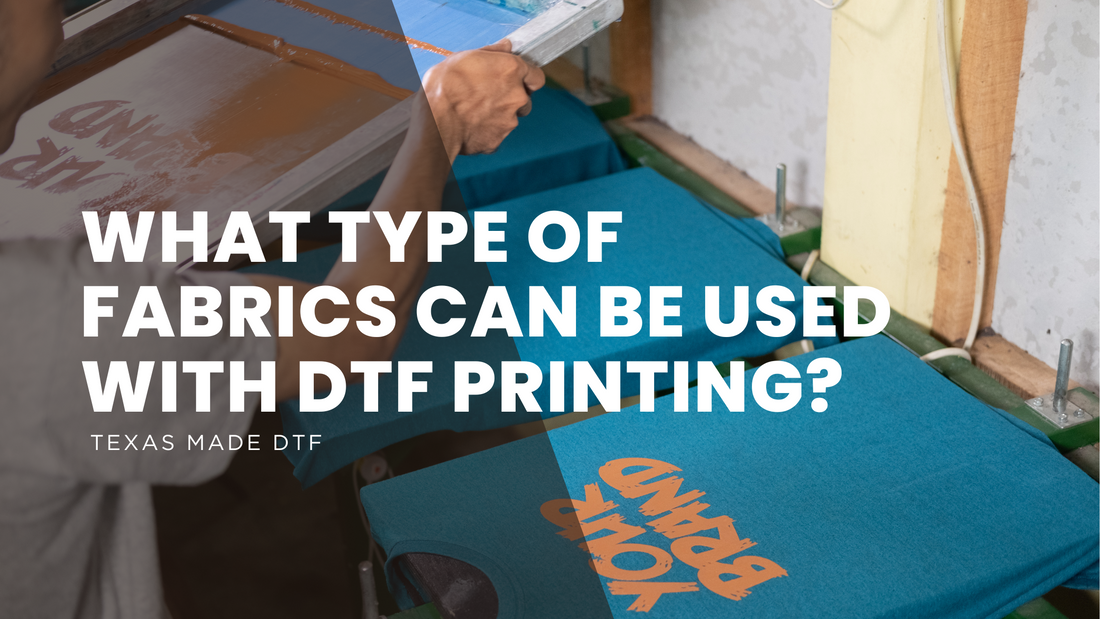DTF printing (Direct-to-Film printing) has transformed the garment printing industry with its ability to produce vibrant, long-lasting designs on a wide variety of materials. However, a common question remains: What fabrics are truly compatible with DTF printing?
In this article, we’ll break down the best fabrics for DTF printing, explore how the process interacts with different materials, and share tips to get flawless results on any garment type.
What is DTF Printing?
DTF (Direct-to-Film) printing is a digital printing method where a design is printed onto a special film and then transferred to a garment using heat and adhesive powder. This method allows for rich color reproduction and excellent durability, without the need for pretreatment, which is required in DTG (Direct-to-Garment) printing.
What makes DTF especially powerful is its versatility; it can be applied to many fabric types, opening up opportunities for apparel brands, print shops, and custom merch creators.
How DTF Printing Works with Different Fabrics
Unlike other printing methods that are limited to cotton or light fabrics, DTF printing adheres to both natural and synthetic materials. Once the design is printed on the film and coated with adhesive powder, it can be transferred onto a variety of fabrics using a heat press. The adhesive ensures strong bonding with the fabric, regardless of its fiber type.
However, not all materials yield the same results in terms of softness, stretch, and longevity. That’s why choosing the right fabric matters.
Top Fabrics Compatible with DTF Printing
Here’s a closer look at the most commonly used fabrics for DTF printing and how they perform:
1. Cotton
-
Excellent color retention
-
Soft feel
-
Common in t-shirts and casual wear
Cotton is one of the best choices for DTF printing due to its absorbent nature and widespread availability.
2. Polyester
-
✅ Smooth surface for sharp prints
-
✅ Ideal for sportswear
-
⚠ May feel slightly stiffer due to adhesive
Keywords: DTF on polyester, DTF printing compatible fabrics
Unlike sublimation (which works only on light-colored polyester), DTF printing works on dark or light polyester, making it a game-changer.
3. Cotton-Poly Blends
-
✅ Best of both worlds—soft and durable
-
✅ Ideal for hoodies, polos, and mixed-fabric items
Blends allow you to preserve the softness of cotton while benefiting from the durability and flexibility of polyester.
4. Nylon
-
✅ Compatible with some adhesive formulations
-
⚠ Requires heat control to avoid melting or shrinking
Used often in outdoor or technical garments. Make sure to test heat settings carefully.
5. Fleece, Canvas, and Other Specialty Fabrics
-
✅ Works well with the right pressure and temperature
-
⚠ Thicker fabrics need higher pressure
These are perfect for tote bags, jackets, and premium merch.
Pros and Cons of Each Fabric Type
Cotton
It is a top choice for DTF printing due to its softness, breathability, and ability to hold vibrant colors. It's ideal for t-shirts and casual wear. However, it may shrink slightly if not pre-washed before printing.
Polyester
It offers durability and produces sharp, detailed prints, especially for sportswear and uniforms. The surface is smooth, allowing clean transfers, but it can feel less breathable and slightly stiff depending on the adhesive used.
Cotton-polyester blends
It combines the strengths of both fibers, offering a soft yet durable garment that handles DTF printing well. These blends are commonly used in hoodies, sweatshirts, and polo shirts. The main consideration is adjusting your press settings to balance the properties of both materials.
Nylon
While a bit trickier, it can work with DTF printing when the right adhesive and heat settings are used. It's lightweight and commonly used in jackets and bags, but it’s sensitive to high heat and may warp or melt if not handled carefully.
Canvas and fleece
These are thicker fabrics that also work well with DTF, especially for bags, outerwear, and winter garments. They require higher pressure and firm contact during pressing to ensure a strong, even transfer.
Tips for Getting the Best Results on Different Fabrics
To ensure long-lasting, professional-looking DTF prints across fabric types, keep these tips in mind:
-
Adjust heat and pressure based on fabric thickness and sensitivity
-
Pre-press garments to remove moisture and flatten the surface
-
Use high-quality adhesive powder for stronger bonding
-
Store DTF transfers in a cool, dry place to maintain print quality
-
Test print when working with unfamiliar materials
Fabrics to Avoid with DTF Printing
While DTF is incredibly versatile, certain fabrics may pose challenges:
-
Silk – prone to damage under heat and may not bond well
-
Leather – uneven surface and sensitive to pressure
-
High-stretch spandex – adhesive may crack under extreme stretch
For these materials, other techniques like screen printing, embroidery, or heat transfer vinyl may be better suited.
Final Thoughts
DTF printing opens up endless possibilities for fabric compatibility, from everyday cotton to durable polyester and blended textiles. Whether you're creating streetwear, uniforms, or promotional items, understanding which fabrics work best for DTF printing helps ensure your prints are not only beautiful but built to last.
Looking for premium DTF supplies or custom transfers?
Visit TexasMadeDTF.com and explore everything you need to take your prints to the next level.

